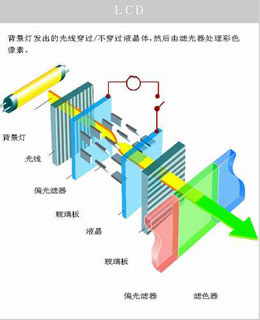Organic light-emitting diodes take advantage of the properties of electron luminescence: certain materials illuminate when current is passed through. And from every angle, it is clearer than the LCD.
O LED display principle
The simplest form of an organic light emitting diode consists of a layer of luminescent material embedded between two electrodes. When the voltage is input, the carriers move through the organic layer until the electron holes recombine, thus achieving energy conservation and releasing excess energy as light pulses. At this time one of the electrodes is transparent and the emitted light can be seen. It usually consists of indium tin oxide (ITO).
OLED display material
The color of light is related to the material. One method is to work with small molecular layers, such as aluminum oxide. Another method is to embed the activated pigment into the long chain of the polymer, which is very soluble and can be made into a coating.
OLED is more efficient
Electron flows and carriers are usually unequal. This means that when the dominant carrier passes through the entire structural layer, it does not encounter electrons from the opposite direction, and the energy consumption is large and the efficiency is low. If an organic layer is replaced by two different organic layers, a better effect can be obtained: when the boundary layer of the positive electrode supplies carriers, the negative side is very suitable for transporting electrons, and the carrier is between the two organic layers. When passing, it will be blocked until there are carriers moving in the opposite direction, so the efficiency is obviously improved. After the thin boundary layer is recombined, a small bright spot is produced to illuminate. If there are three organic layers for transporting electrons, transporting carriers, and illuminating, the efficiency will be higher.
OLED emits light, while LCD does not emit light
The biggest difference from the liquid crystal display (LCD) is that the organic light emitting diode itself is the light source. In liquid crystal displays, the input voltage is different, and the tiny liquid crystals change direction, which causes white light from the background light source to pass/block. This principle also limits the viewing angle. Seen from the side, the effect is very poor, or can not be seen at all. If the liquid crystal display has a pixel error due to a wrong color of the light, such an error hardly occurs in the organic light emitting diode.
Active array or passive array
Like liquid crystal displays, organic light-emitting diodes also have variations in active and passive arrays.
In passive array organic light-emitting diodes, the position of the pixel is displayed by the number of rows and columns, affected by the voltage. In the active array of organic light-emitting diodes, the electron reflow area acts as a photosensitive underlayer, and each pixel can be controlled by at least two crystals. (small soup)

Card Reader advantage:
External memory expansion for ipad/ iphone/ ipod touch
Secured file encryption for private filesManage all data directly on the iOS-Device
(create, copy, move, delete, rename, open in and many more)
Playback Videos/Music directly from external memory
Backup and restore your contact list
Document viewer for all major file formats
Voice recorder/ Text editor
Dropbox support
Support ios 5.1 above
Read speed 6MB/S-8MB/S write speed 4MB/S-5MB/S
Free App from app store for communication between your devices and i-FlashDrive
Card Reader
Card Reader,Card Readers,Mobile Card Reader,Smart Card Reader
Dongguan City Leya Electronic Technology Co. Ltd , http://www.dgleya.com